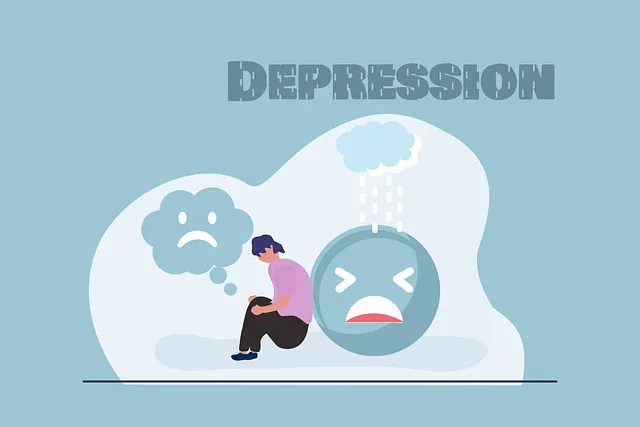Burnout among healthcare providers at Greenwood Village Kaiser Permanente mental health locations is caused by heavy caseloads, long hours, and complex patient needs, leading to stress, emotional exhaustion, and decreased job satisfaction. To combat this issue, the organization should implement targeted interventions like enhanced support systems, work-life balance initiatives, mental health education, conflict resolution training, and stigma reduction. Early recognition of burnout signs, promotion of mental health awareness, access to counseling services, cultural competency training, and evidence-based strategies are key. Prioritizing self-care practices, mindfulness techniques, and employee support programs can further mitigate risks. Ultimately, a cultural shift towards collective well-being and work-life balance is essential for maintaining a healthy and engaged workforce at these locations.
“Healthcare provider burnout is a growing concern, particularly within mental health services in areas like Greenwood Village. This article explores comprehensive strategies to combat burnout at Kaiser Permanente’s mental health locations. We delve into the root causes, from understanding the unique challenges faced by healthcare workers to recognizing early warning signs. By combining evidence-based practices, self-care initiatives, and organizational cultural shifts, this guide offers actionable steps for promoting work-life balance and preventing burnout among dedicated professionals in Greenwood Village Kaiser Permanente mental health locations.”
- Understanding Burnout Among Healthcare Providers at Kaiser Permanente Mental Health Locations in Greenwood Village
- Identifying Signs and Symptoms of Burnout Early On
- Evidence-Based Strategies for Prevention and Work-Life Balance
- The Role of Self-Care, Mindfulness, and Employee Support Programs
- Organizational Cultural Shifts Needed to Combat Burnout at Kaiser Permanente
Understanding Burnout Among Healthcare Providers at Kaiser Permanente Mental Health Locations in Greenwood Village

Burnout among healthcare providers is a growing concern, particularly within mental health settings like those at Kaiser Permanente Mental Health Locations in Greenwood Village. This issue stems from various factors, including heavy caseloads, long working hours, and complex patient needs. The unique demands of mental health care can lead to high stress levels, emotional exhaustion, and depersonalization, ultimately impacting the well-being and effectiveness of healthcare providers.
At Kaiser Permanente’s Greenwood Village locations, recognizing and addressing burnout is crucial. Implementing tailored interventions, such as enhanced support systems, improved work-life balance initiatives, and mental health education programs design to foster resilience, can help combat these challenges. Additionally, integrating conflict resolution techniques and stigma reduction efforts plays a vital role in creating a healthier and more supportive environment for both patients and providers.
Identifying Signs and Symptoms of Burnout Early On

Burnout prevention starts with recognizing the signs early on. Healthcare providers often exhibit physical, emotional, and mental symptoms that can indicate burnout, especially in high-pressure settings like Greenwood Village Kaiser Permanente mental health locations. These may include chronic fatigue, increased irritability or cynicism towards work, reduced performance, and a sense of detachment from patients or colleagues.
Promoting Mental Health Awareness and implementing support systems are crucial strategies. This includes encouraging open communication about workload stress, offering access to counseling services, and providing opportunities for rest and recovery. Additionally, Healthcare Provider Cultural Competency Training can play a significant role in preventing burnout by fostering an inclusive work environment that values diverse perspectives and supports the well-being of all staff.
Evidence-Based Strategies for Prevention and Work-Life Balance

Preventing burnout among healthcare providers is a critical aspect of maintaining high-quality patient care. Evidence-based strategies focus on promoting work-life balance, emotional well-being, and resilience. One effective approach involves integrating mental health services within healthcare facilities, such as the Greenwood Village Kaiser Permanente mental health locations. These specialized centers offer resources for emotional healing processes, emphasizing the importance of addressing providers’ psychological needs alongside their clinical responsibilities.
Additionally, fostering positive thinking through mindfulness practices, stress management techniques, and peer support networks can significantly mitigate burnout risks. Risk management planning for mental health professionals is also vital. This includes setting clear boundaries between work and personal life, encouraging regular breaks, and providing access to professional counseling services. By implementing these strategies, healthcare organizations can create a supportive environment that enhances job satisfaction, improves patient outcomes, and ensures the long-term well-being of their providers.
The Role of Self-Care, Mindfulness, and Employee Support Programs

In the quest to prevent healthcare provider burnout, self-care practices and mindfulness techniques emerge as potent tools. Healthcare professionals, especially those at bustling locations like Greenwood Village Kaiser Permanente mental health sites, must prioritize their well-being amidst demanding work schedules. Incorporating regular exercise, adequate sleep, and balanced nutrition into daily routines acts as a foundation for stress reduction methods. These holistic approaches not only enhance physical health but also contribute to improved mood management and emotional healing processes, ensuring professionals can effectively care for others while maintaining their own mental fortitude.
Employee support programs play a pivotal role in fostering a culture of resilience and camaraderie. Organizations like Kaiser Permanente can facilitate these programs through mentorship initiatives, peer support groups, and access to on-site counseling services. By prioritizing open communication, recognizing individual struggles, and offering accessible resources for emotional healing processes, healthcare facilities can create an environment that nourishes the well-being of their providers. Such supportive systems not only mitigate burnout but also foster a deeper sense of belonging and purpose among employees.
Organizational Cultural Shifts Needed to Combat Burnout at Kaiser Permanente

At Greenwood Village Kaiser Permanente mental health locations, addressing burnout among healthcare providers requires a strategic shift in organizational culture. The traditional focus on individual resilience must evolve to prioritize collective well-being and work-life balance. By fostering an environment that encourages open communication, empathy building strategies, and effective mood management techniques, the organization can create a supportive system that prevents burnout before it occurs.
This cultural transformation involves re-evaluating work expectations, implementing flexible scheduling, promoting peer support networks, and integrating anxiety relief programs into routine staff training. These measures aim to normalize conversations around mental health, reduce stigma, and ensure providers feel valued, supported, and empowered in their roles. Such shifts are crucial for maintaining a healthy, engaged workforce at Greenwood Village Kaiser Permanente.
Burnout among healthcare providers is a pressing issue, but by implementing evidence-based strategies and organizational cultural shifts at Greenwood Village Kaiser Permanente mental health locations, we can foster a healthier work environment. Early identification of burnout signs, prioritizing self-care, mindfulness practices, and supportive programs are key components to preventing this epidemic. Through these measures, Kaiser Permanente can ensure its mental health professionals maintain resilience, ensuring quality patient care for years to come.






